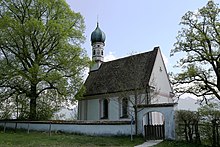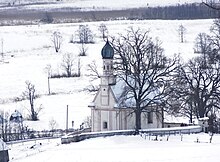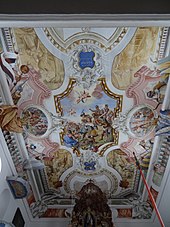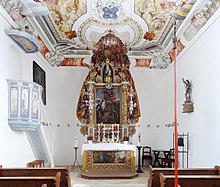Ramsach Church
As Ramsachkircherl is baroque church of St. George in Ramsach south of Murnau on the northern edge of Murnau moss in Upper Bavarian district of Garmisch-Partenkirchen referred. It can be traced back to the 14th century, its core is late Gothic and today has a baroque version after major renovations in the 15th and 17th centuries.
Building
The Georgskirche is a simple hall building with a rectangular floor plan and a gable roof . Above the east wall there is a roof turret with an initially square cross-section on which an octagonal turret stands, which ends in a pointed onion dome. The two windows on each longitudinal facade are round arches, the simple and low entrance from the west is a pointed arch. A magnificent baroque portal is painted around this door, the windows and the small ledges under the eaves and gable as well as the edges of the building are colored with fascia and partly decorated with simple ornaments. The foundation made of boulders is visible on the south wall , the uncut stones, like the pointed arch, point to the medieval origins of the building.
The interior is architecturally simple, the only structure is three steps to the chancel. A choir is not separated. In the west there is a small gallery, under which a grating closes the anteroom. The structure that is preserved today was presumably determined by major alterations in the 15th and 17th centuries.
The baroque church is located on a small hill that blends into the slope of the Molasse ridge, which borders the Murnau moor to the north. It is surrounded by a cemetery that is now abandoned . The church and churchyard are enclosed by a wall with a medieval entrance. To the west of the church is the former Ramsach farm, a log building with a flat saddle roof and decorative collar from the 18th century, today an inn with a beer garden. The church and inn are entered on the Murnau list of monuments.
history
The oldest structurally verifiable parts of the church in Ramsach point to the 14th century. The first mention of this in a document from 1332, according to which the church was transferred from the property of the St. Mang monastery in Füssen to the Ettal monastery , fits in with this . In 1444 Abbot Johann von Ettal exchanged three farms, including Ramsach including the church there, for another farm with the wealthy Murnau Katharinenstiftung. Ettal initially retained ecclesiastical responsibility until 1453, in agreement with the citizens of Murnau, to the Church of St. Michael on the island of Wörth , which was only indirectly subject to Ettal supervision. This document is the first to show St. Georg as the patron saint of the Ramsachkircherl, whereby the dragon slayer Georg is related to the local legends about the Lindwurm of Murnau, which is recorded in the Murnau market coat of arms.
When Murnau was raised to a parish in 1744, St. Georg near Ramsach was transferred to the new parish as a branch church . The citizens of Murnau had been maintaining the church for several years and paid for the construction work, which is proven by the invoices they received. In 1739 the roof was repaired and a new false ceiling was put in, and the local painter Augustin Bernhard painted the exterior again. In the following year new window panes were installed, the church pews were replaced and painter Bernhard painted the ceiling. The version of the church that was created at that time has been preserved to this day and has been restored several times, most recently between autumn 2005 and May 2007, when the interior of the church and the furnishings were completely restored, the church was electrified and an alarm system was installed.
Furnishing
The ceiling painting by the local painter Augustin Bernhard from 1740 fills the entire ceiling area. The ceiling is flat with a small fillet . The painter simulates a much more elaborate architecture by painting the throat with what appears to be a balustrade . The pseudo-architecture continues over the surface of the ceiling in the form of attachments, ledges, friezes and profiles. Ornaments made of stucco and draperies made of fabric are simulated in the painting. The design is not designed to be perfectionist, but breaks with the illusion in many places. On the one hand, the central field of the ceiling painting gives the impression of a breakthrough in which a person is depicted sitting on the supposed wall edge. On the other hand, the picture the seated person looks at is designed as a flat panel painting without any suggestion of a suitable perspective. Art historians attribute this not only to the provincial painter's lack of skills, which can be seen in some places, but also see this as a deliberate break, as is typical of the southern German late Baroque and then the Rococo .
The ceiling painting shows legends from the life of St. George in several fields and culminates in his execution in the central field. Allegories of Christian virtues are depicted in the corners of the building .
Altar structure and altarpiece are older than the painting. The year 1663 and the initials FP of the founder are attached to it. The picture represents the most famous legend from the life of St. George, it shows him as a knight on horseback while he kills the dragon with his lance. In the background of the flat river or moor landscape in front of mountains stands the little princess who Georg rescues from danger of death.
Significantly older figures are integrated into the altar, presumably from a previous altar. To the left and right of the picture are late Gothic statues from the 15th century. They represent John the Baptist and Saint Catherine . The latter refers to the wealthy Katharinenstiftung in Murnau, which had owned the church since the middle of the 15th century. John could refer to an older patronage before St. George. In the altar structure, above the picture, a niche was provided in which the oldest statue in the church sits: a Madonna from the 14th century, with a triple crown and the apple as an attribute .
There are more statues on consoles on the side walls. On the south wall in front a rather small, late Gothic Georg around 1500; on the north wall is a late Gothic Christ who is typically depicted as a man of pain . In the rear of the south wall there is a jointed doll of St. Joseph .
Further furnishings of the church are:
- two glass chandeliers (18th century): from the long-defunct glassworks of the Ettal monastery, which was located in the nearby Grafenaschau . The red feather flowers blown out of glass between the altar candles also come from this glassworks.
- the wooden pulpit with sound cover (partly 17th and 18th centuries) with biblical motifs: Christ as the good shepherd, a grain shovel set in the wind, which symbolizes how God "separates the wheat from the chaff", and the dry fig tree, the god always brought back to life.
Next to the altar hangs in a specially made frame an approximately 60 cm high hand bell forged from sheet iron and riveted. It goes back to shapes that have been in use since Roman times, the shoulder lobes are of a type that can be traced back to the Monastery of Iona in Scotland. The local legend goes back to this that the bell came from the middle of the 8th century and was brought to Upper Bavaria by Irish-Scottish wandering monks. It is not believable, the bell is rather associated with the church and monastery of St. Michael on the island of Wörth in the Staffelsee. There is also an indication that an unspecified bell from the 10th to 12th centuries was kept in nearby Obereglfing until 1750 , the whereabouts of which are not known there. The bell of St. George is still called one of the oldest preserved church bells in Europe.
Legend
A founding legend refers to a previous building of the church from the middle of the 8th century, as recorded in a ceiling inscription. However, it cannot be proven archaeologically and is considered unlikely due to the settlement history in the region. The legend names both Bonifatius and Saint Mang (Magnus von Füssen) as the founders in different versions . The latter is considered a back projection of the documented ownership situation of the St. Mang monastery in Füssen at the church, when it was documented in the 14th century. Because of this legend, St. Georg in Ramsach is locally considered to be the oldest church in the region and is also called "s' Ähndl " by locals , meaning the ancestor of all churches.
literature
- Klaus Kratzsch, Stefan Winghart: The Ramsachkircherl on the Murnauer Moos. Kunstverlag Josef Fink, 2nd edition, Weiler im Allgäu 2012, ISBN 978-3-89870-554-7 .
Web links
- Catholic parish community Murnau: St. Georg im Murnauer Moos - partly misleading representation based on legends
Individual evidence
- ↑ a b Unless otherwise stated, the description is based on: Gerhard R. Koschade, Marion Hruschka: Kirchliche Kunst - Filialkirche St. Georg in Ramsach . In: Markt Murnau am Staffelsee - contributions to history . Published by Markt Murnau am Staffelsee, EOS Verlag, 2002
- ↑ Stefan Winghart: An early Christian iron bell from the Ramsach Church near Murnau a. Staffelsee . In: Lech-Isar-Land 2002, pages 87-92
Coordinates: 47 ° 39 '58 " N , 11 ° 11' 7.9" E




